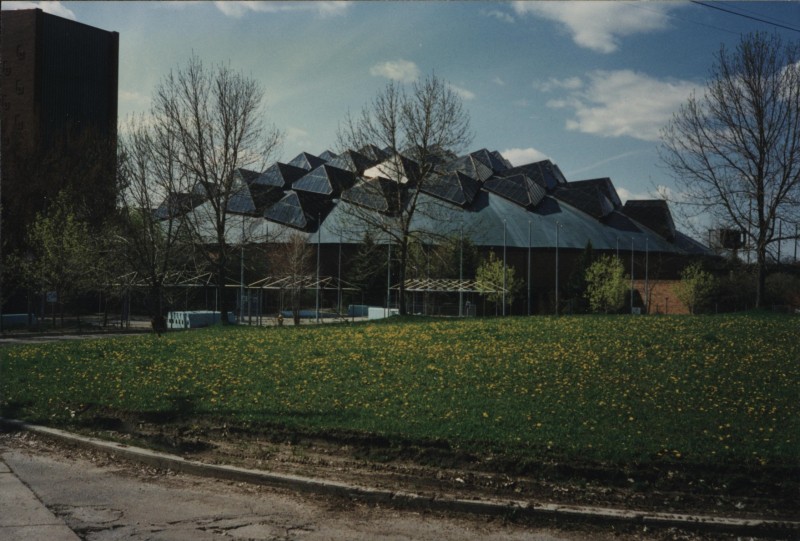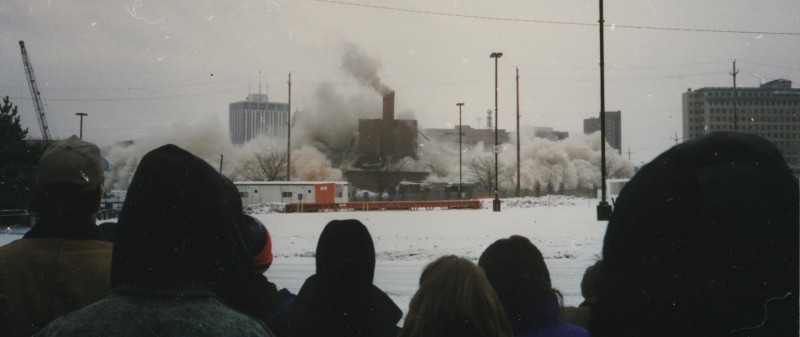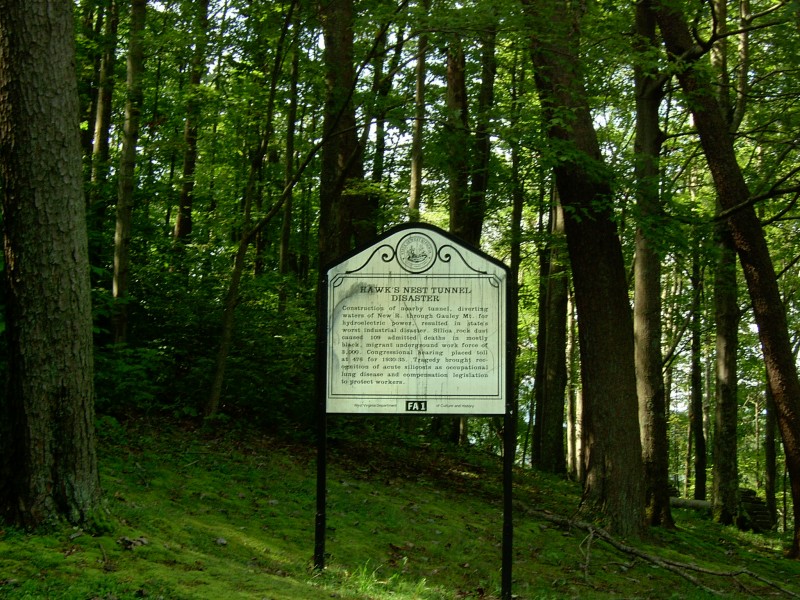The public history of the Flint water crisis (Part 2)
25 March 2016 – editors

AutoWorld Dome, ca 1990s. Photo credit: Grant Burns
A personal perspective on the Flint water crisis
My thoughts on the Flint water crisis stem from a personal perspective, as well as my academic interests in deindustrialization, African American history, and heritage tourism. When I was two years old, my dad was offered a job as a reference librarian at the University of Michigan-Flint. We moved from Ann Arbor to Flint in 1978 and lived there until the year 2000. We lived on Nebraska Avenue, just down the street from the (now demolished) AC-Delco plant, in a small Cape Cod house that looked nearly identical to all of the others on the street. I attended Washington Elementary School (now closed, as are many of Flint’s public schools), and then St. John Vianney School, and Powers Catholic High School.
Over the years, our neighborhood declined and became increasingly dangerous; murders occurred on the next block over shortly after my parents finally were able to sell their house. One day, in the early 2000s, I returned to Flint to visit friends. I decided to drive down our street to look at our old house. It had been foreclosed: the entire contents of the house were strewn on our front lawn. I wept. I no longer called Flint “home,” but–despite its flaws and reputation–it was the city where I grew up, met friends, played music at summer band camps, and started to become the public historian that I am today.
Witnessing that physical disruption to my old childhood house was traumatic. Reading and seeing the water crisis unfolding has again triggered an odd jump back and forth between my childhood memories and the present day. If we still lived there now, what would we do? What if this had happened when I was a child–what would we have done? When did I bring my young daughter to Flint–was it in 2013, or 2014? Did she drink the water at the museum we visited? After doing some research, I found that had my family continued to live in our same house on Nebraska Avenue, it is likely that we would not have had drunk contaminated water. According to a lead map guide recently published by the Detroit Free Press, our old address has not reported lead contamination at more than 15 parts per billion (this assumes the house is occupied, and the current resident has submitted water samples). Yet, lead concentrations at another Nebraska Avenue address just a few blocks away have been measured at more than 728 ppb. The elementary and middle school I attended, St. John Vianney, has been flagged at 41 ppb.
To view the map: http://www.freep.com/story/news/local/michigan/flint-water-crisis/2016/02/1…
These questions are, of course, coming from a place of privilege. I do not live there now, and I only visit on occasion. How are Flint’s current residents–so many of whom were already vulnerable before this crisis occurred–going to cope with a disaster on this scale? As Thomas Henthorn has mentioned in his previous post on this topic, the water crisis is, perhaps, the catalyst–the ultimate marker of how the city’s residents have been demoralized and disregarded by those in power at the city, state, and federal level for perhaps at least a half century now–and, indeed, far longer for non-white residents.
My own research on Flint has focused on the construction of AutoWorld during the 1980s. This failed combination of museum and theme park is neither directly connected nor comparable to this urgent public health crisis, but I find it interesting that both AutoWorld and the decision to switch the water supply were intended to somehow “save” Flint, one way or the other. City planners hoped AutoWorld would draw tourists from across the Midwest and thereby revitalize a declining city; the 2014 decision to switch the city’s source of drinking water from Lake Huron to the Flint River was intended as a cost-saving measure. In both cases, these measures failed, and cost far more than initially anticipated. And, of course, the tens of millions of dollars it will take to repair the water pipes barely begins to address the cumulative effects of the lead poisoning suffered by infants and children in Flint, and the outrageous treatment of the city’s residents by those in power.

AutoWorld implosion, 1997. Photo credit: Grant Burns
Writer Amy Davidson had an excellent piece in The New Yorker on January 22, titled “The Contempt that Poisoned Flint’s Water”. In it, she discusses how Flint residents had been complaining of brown, foul-smelling water for some time. The state knew and did nothing, instead blaming the problem on residents’ shallow complaints about aesthetics. Brown water that “passed” a few (clearly tampered with) tests should be good enough for Flint, right? As Davidson argues, “It was as if state officials thought that it was all a cultural problem, poor people being frivolous instead of drinking water that had long been, as one memo put it, ‘perfectly fine.'” As the disturbing news continues to unfold (most recently about the state providing filtered water to its Flint employees before finally distributing water to local residents), we, as public historians, as social justice advocates, as fellow human beings, have an obligation to speak truth to power–and thus follow in the footsteps of those who have long been speaking up and acting out in Flint.
~ Andrea Burns is an associate professor at Appalachian State University where she supervises the MA concentration in Museum Studies and Public History, and teaches public history to both undergraduate and graduate students. Her book, From Storefront to Monument: Tracing the Public History of the Black Museum Movement (University of Massachusetts Press, 2013) received the National Council on Public History Book Award in 2015. Dr. Burns earned her PhD in History from the University of Minnesota in 2008, and a BA in History from Michigan State University.
Environmental injustice in Flint and beyond
I recall in the late 1980s my in-laws from suburban-gated-community Detroit speaking contemptuously of what “those people” had done to the cities of Flint and Detroit. I tried to keep the family peace, but I knew that they had been part of the “white flight” and ultimately unconscionable neglect of these great American cities to which Henthorn refers. As my colleagues have suggested, the unfolding nightmare in Flint is a multi-layered socio-economic and environmental injustice that needs to be seen first through the historical lens of the city itself and its deeper, decades-old abandonment.
Beyond Flint, what also frames this horror is a century or more of episodes of environmental injustice that have often been defined by race, class, and communities “out of sight and mind.” In the early 1930s, for example, hundreds of mostly African American workers, recruited from the deep South, went to their deaths while digging the Hawk’s Nest Tunnel in Gauley Bridge, West Virginia. Union Carbide’s on-site managers wore protective masks while the workers tunneling deep into the mountain were exposed daily to extreme amounts of silica dust, most succumbing to silicosis within months. This came to mind when I heard that many months ago state workers in Flint were quietly provided with bottled water while the good people of Flint continued to be exposed to lead toxicity in their water.

Hawks Nest Tunnel historical marker. Photo credit: Brian Powell on Wikimedia Commons
Similarly, in the atomic testing program of the early 1950s, Atomic Energy Commission technicians in the early 1950s gathering data about radiation levels were heavily protected while the good people of St. George, Utah–a “low-use segment of the population,” according to the AEC–were exposed to dangerous levels of radioactivity. Childhood leukemia, never before seen in St. George, became tragically common.
These episodes litter the pages of US environmental history. (There is, too, a national history of infrastructure neglect to which the Flint crisis is linked as well.) It falls to environmental and public historians to, as Andrea and Thomas have argued, stand with the people of Flint however and wherever we can, seeking opportunities to bring this story–and the local and national history in which it is embedded–into a wide range of public forums across the country.
~ Chris Magoc is the Department Chair, Professor, and Associate Dean of the School of Social Sciences at Mercyhurst University. He is also co-founder and president of Preservation Erie, where he is spending much time trying to advance the development of this regional nonprofit organization dedicated to preserving northwest Pennsylvania’s historic built environment.
Editor’s note: This series (see the first post here) reflects multiple perspectives from public historians, environmental historians and museum scholars on the emerging public history of the Flint water crisis that began in April 2014 but was not brought to light publicly until last summer. Details are still emerging, but this series aims to spark discussion among public historians about appropriate reactions to this event and others like it. Each post will pair two perspectives in a conversational format.




Please contact me [email protected]